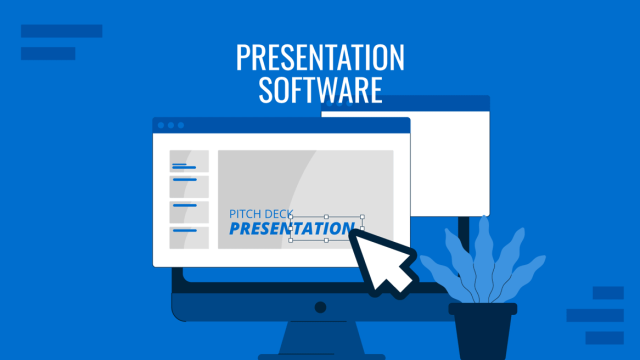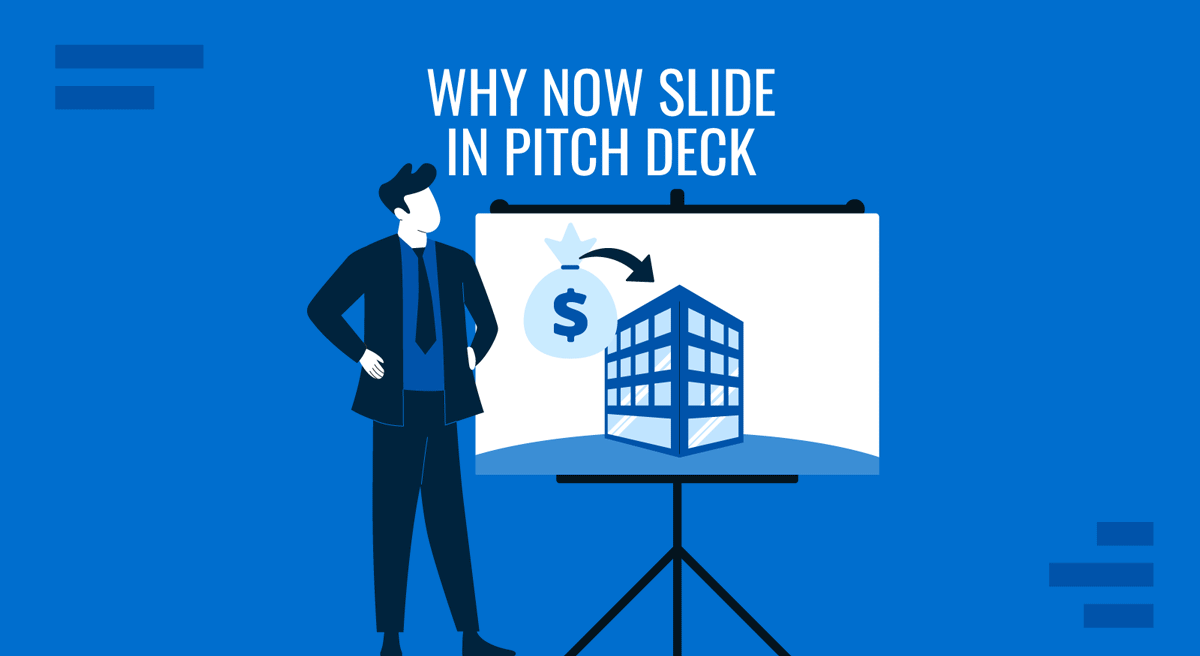
The Why Now slide answers a single but crucial question every investor silently asks: Why is this the right moment for this company to exist? Timing determines whether a great idea becomes a viable business or a missed opportunity. This section of the pitch is not about product features or market size; it’s about the alignment between market readiness, technological maturity, consumer behavior, and macroeconomic conditions. From the presenter’s standpoint, this slide must convincingly demonstrate that current conditions uniquely favor the startup’s success. A strong “Why Now” argument transforms curiosity into urgency.
In this article, we’ll explore the elements that can deliver a stellar Why Now slide for a pitch deck presentation, as well as common mistakes to avoid hindering your presentation’s performance.
Table of Contents
- Why Timing Matters in Investor Presentations
- Why Include a Why Now Slide in Your Pitch Deck
- What to Include in a Why Now Slide
- Which PowerPoint Graphics Strengthen a Why Now Slide for an Investor Pitch
- Mistakes to Avoid When Building the Why Now Slide
- FAQs
- Final Words
Why Timing Matters in Investor Presentations
Every investor evaluates three key elements: team, traction, and timing; however, timing often dominates the decision. A market can reject an innovation simply because it arrives too early or too late. Presenters who understand this dynamic use the Why Now slide to demonstrate that the market window is open and actionable.
When crafting this message, consider the concept of convergence. Are multiple trends intersecting to enable your business model? For instance, widespread 5G adoption makes your real-time AR product viable; new regulations favor digital identity platforms, or remote-work habits might amplify demand for your collaboration tool. The presenter’s job is to identify the combination of triggers that didn’t exist five years ago and may not persist for five years from now.
This slide should contain concise factual signals, industry growth rates, adoption curves, regulatory shifts, or technology cost reductions. Each data point must directly justify why investors should bet today. Avoid generic claims about “rapid digitalization” or “growing demand.” Instead, quantify: “Cloud API costs dropped 40 % since 2020, enabling profitable unit economics for SMBs.” Precision establishes authority, while vague enthusiasm undermines it.
Why Include a Why Now Slide in Your Pitch Deck
Some founders mistakenly embed timing arguments across other slides, such as market, product, and traction, without isolating them for analysis. The result dilutes their impact. A dedicated Why Now slide crystallizes the entire investment rationale into a single frame of reference. It links past developments with present readiness and near-term acceleration.
From a storytelling presentation perspective, this slide is your turning point. Up to this point, the deck describes problems, markets, and solutions. The Why Now slide answers why urgency exists. Without it, the pitch feels static. With it, the narrative acquires momentum.
Structurally, the Why Now slide typically follows the market analysis or problem-solution section. By this stage, the audience understands what you are building. Now, they must see why the environment will reward it. This placement also bridges toward traction and milestones, preparing investors to interpret your progress within a favorable temporal context.
Visually, the Why Now slide can employ short bullet statements, icons, or concise graphs. The goal is to present three to five external drivers, supported by verifiable data, including emerging consumer habits, declining cost curves, new regulations, competitive gaps, or technological enablers. Each should have a timestamped element (“post-pandemic shift,” “2024 AI act approval,” “battery density +80 % since 2019”). These time anchors communicate that you’re not recycling stale trends.
For the presenter, this slide also offers a strategic advantage during the Q&A session. When investors question the feasibility, timing arguments become your defense. If you can demonstrate that market friction has recently decreased or distribution channels have expanded, skepticism loses its strength. In short, this slide converts external context into an internal advantage.
What to Include in a Why Now Slide
A well-built Why Now slide contains four content layers: macro trends, technological or infrastructural shifts, behavioral validation, and competitive or regulatory openings. Each must connect logically to your product’s success path.
Macro Trends
Start with quantifiable macro signals. These may include market growth rates, demographic changes, or global disruptions creating new demands. Present them as snapshots, not essays. Charts showing CAGR projections, user-base explosions, or sector investment surges can convey magnitude instantly. Avoid cherry-picked anecdotes; credibility relies on sourced data.
Recommended lecture: Data-Driven Decision Making
Technological or Infrastructure Shifts
Show how recent advances eliminate previous barriers. For instance, if AI model inference costs fell 60 % in two years, that might unlock your business’s viability. Likewise, if new APIs or devices expand access, show their release timelines to prove novelty. Investors should see that technical timing favors you, not incumbents.
Behavioral or Cultural Validation
Consumer behavior often changes gradually until an external shock accelerates it. Point to measurable adoption, downloads, spending categories, or engagement metrics, that confirm lasting change, not pandemic-driven anomalies. For example: “E-learning hours per user increased 3× and stabilized at 2× pre-2020 levels.” Such framing demonstrates durable momentum.
Regulatory or Competitive Context
Regulation can either suffocate or ignite opportunity. If new privacy laws restrict data harvesting, a compliant analytics startup becomes more valuable. Similarly, if dominant players are distracted or constrained, highlight the resulting gap. The Why Now slide should thus integrate policy awareness with strategic positioning.
Each layer reinforces the same conclusion: external forces finally align with your execution plan. From the presenter’s view, balance persuasion with restraint. The goal is to inform investors, not to sound prophetic. Use their language, risk, adoption curve, total addressable timing, rather than marketing superlatives.
Which PowerPoint Graphics Strengthen a Why Now Slide for an Investor Pitch
Visual structure determines how quickly investors grasp your argument. Since the Why Now slide combines data and narrative, use diagrams that contrast before vs. now or trend acceleration.
Line or Area Graphs
Trend charts (line or area graphs) illustrate growth trajectories and inflection points. Annotate them with short captions: “AI training cost 70% less (2021–2024).” Ensure consistency with your deck’s color palette to maintain visual continuity.
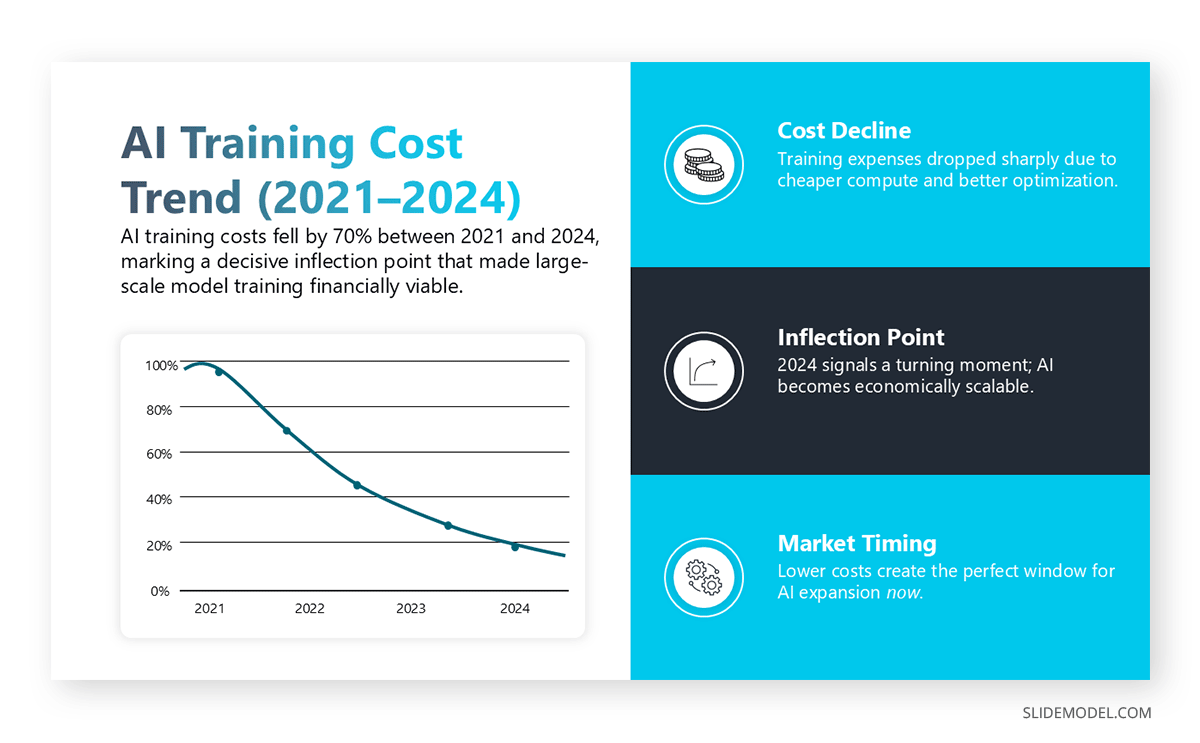
Timelines
Comparison timelines templates can show technological evolution or regulatory changes leading to your product’s feasibility. For example:
- 2018 – Data collection restrictions begin
- 2020 – Cloud API pricing drops
- 2023 – Your solution launches
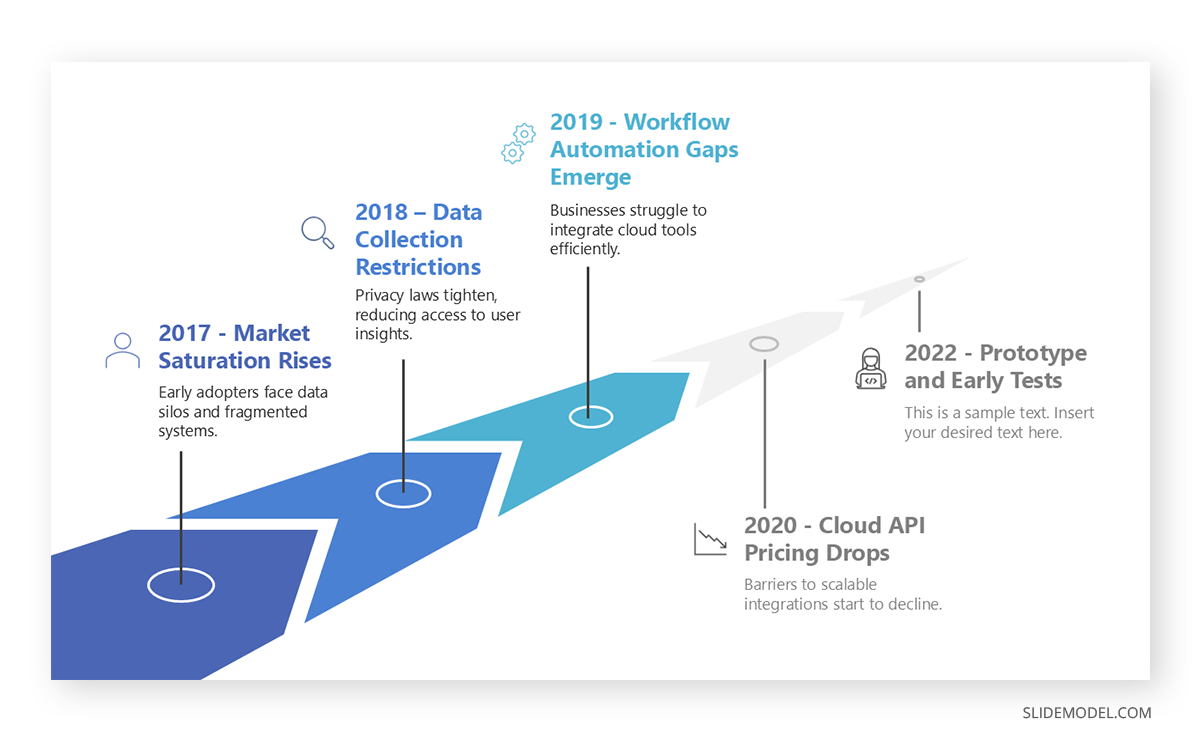
Infographics
Market-momentum infographics, like upward arrows or pulse icons, highlight acceleration without clutter. When you rely on visual metaphors, tie each one to an explicit metric or event. Commonly, metaphor slides have a high visual impact and are easier to associate with once the presentation has concluded.
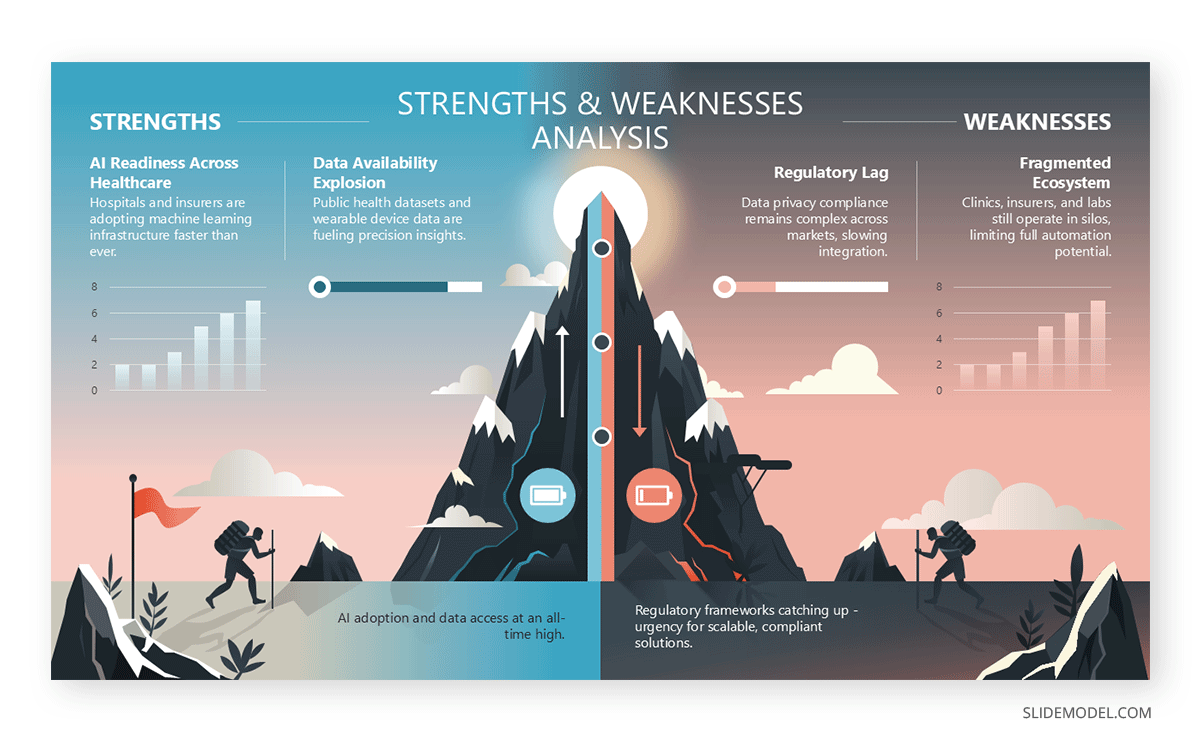
If your argument hinges on consumer adoption, bar charts comparing old vs. new habits work well. Keep labels quantitative (“Share of digital payments worldwide – 45 % -> 62 %”). Avoid decorative elements that add visual noise.
Some presenters use cause-and-effect diagrams to link triggers: “Regulation > Need for transparency > Our platform fit.” This structure converts complex interdependencies into a single readable flow.
Mistakes to Avoid When Building the Why Now Slide
Vagueness Disguised as Vision
Many founders confuse enthusiasm with clarity. Phrases like “The market is booming” or “Everyone is talking about X” add no analytical weight to the discussion. Every claim must be tied to data, a date, or an event. Without proof, investors perceive overconfidence rather than insight.
Outdated or Unverifiable Data
Using pre-pandemic statistics or unsourced numbers undermines trust. Cite recognized industry reports or recent government data. If your figures are proprietary, clarify the methodology briefly when speaking. Accuracy outweighs volume.
Excessive Complexity
A Why Now slide should be absorbable in ten seconds. If you cram multiple charts, tiny fonts, and overlapping trend lines, the audience will tune out. Simplify to two or three key drivers, and explain them verbally during the presentation.
Overlapping with Market or Problem Slides
Avoid redundancy. The Why Now slide focuses on timing, rather than market size or pain description. If you rehash the problem, you dilute the impact. Keep focus on temporal catalysts, not on repeating need statements.
Ignoring Counter-Timing Risks
High-profile investors appreciate awareness of potential reversals. If the favorable condition is temporary, such as a subsidy or a pandemic tailwind, acknowledge it and explain the mitigation measures. This displays maturity rather than weakness.
Poor Visual Hierarchy
Ensure the central insight stands out. Use larger fonts for key metrics and consistent color contrast for chronological elements. Misaligned visuals or inconsistent icon styles reduce credibility even if the content is strong.
From the presenter’s standpoint, credibility depends less on decoration and more on the perception of rigor. Each element on the slide should earn its space through relevance and evidence.
FAQs
What is the primary goal of a Why Now slide?
To demonstrate that current external conditions make the business opportunity unusually favorable. It validates timing as a strategic asset, not a coincidence.
Should I discuss competitors here?
Only if competitive timing is a key part of your case, such as when incumbents are slow to adapt or exit the segment. Otherwise, keep a detailed competitor analysis for its own slide.
Can early-stage startups use a Why Now argument without data?
Yes, but anchor it in external shifts. For example, “recent legal approval of telehealth in Latin America opens the door for X.” Even qualitative changes can indicate a timing advantage.
Is it acceptable to project future catalysts?
Yes, if near-term and verifiable, like an upcoming regulation or technology release. However, avoid speculative predictions beyond one or two years.
How often should I update the slide?
Update it whenever external conditions shift. Outdated timing signals (“post-COVID behavior change”) eventually lose meaning. Replace them with fresher triggers.
What color schemes work best?
Use brand colors sparingly, complemented by neutral backgrounds that highlight graphs. Emphasize “now” elements with accent colors to differentiate them from historical data.
Should I animate the trends?
Subtle transitions can help sequence attention, but static clarity always comes first. Over-animation distracts investors from the logical flow.
Can the Why Now slide be merged with traction?
In short decks, yes. However, maintain distinction: traction shows internal progress; ‘Why Now’ explains external readiness. Combining them risks conflating cause and effect.
Final Words
The Why Now slide transforms a pitch from description to persuasion. It reframes the startup not as a hopeful idea but as a timely response to unfolding realities. For presenters, mastering this slide means mastering narrative context. Investors fund momentum, not nostalgia, and this slide is where momentum becomes visible.
Executed well, it aligns data, insight, and confidence. It proves that you understand not just your product, but the world it operates in, and that the world has finally caught up with your vision. In investor communication, that distinction often separates presentations that interest from those that secure commitment.


